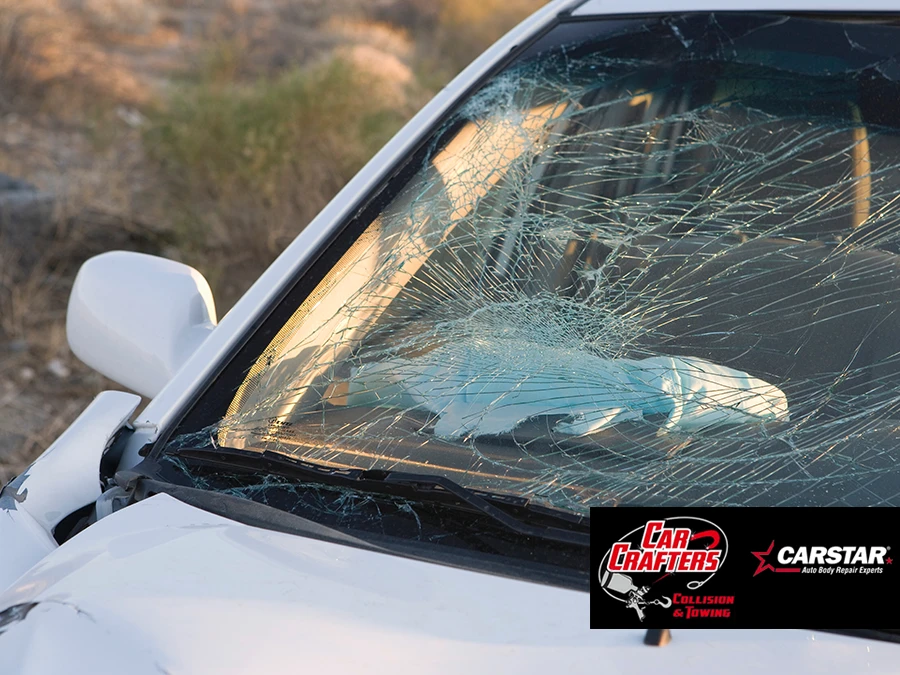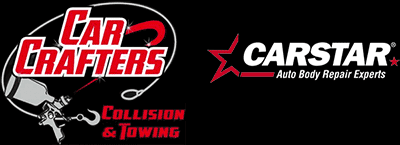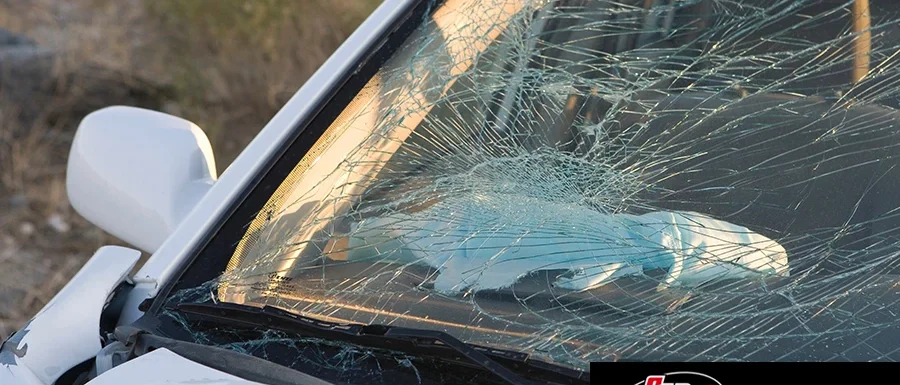
Contact Carcrafters for expert repair following a collision with a deer or other animal in Blue Ridge, GA.
Few driving experiences are as terrifying as having a close call or a direct run-in with a deer. One moment, you’re cruising along, and the next, your world shatters, sometimes literally if the deer is pushed up onto the windshield by the collision.
When you’ve struck a deer in a passenger vehicle, you know it. The sudden, jarring impact can be felt throughout the vehicle. Upon impact, its body can be thrown up into your windshield, run over and crushed under tires, or struck in a way that throws it into the road shoulder. Deer sometimes even run into the sides of moving vehicles, denting doors and smashing glass windows when they do.
If you find yourself in this unfortunate situation in Blue Ridge, Georgia, you probably have a million thoughts racing through your mind.
How do you handle the situation immediately after the impact, and equally important, how can you prevent future wildlife collisions?
This article aims to provide essential information on preventing collisions with deer in Blue Ridge and the surrounding Georgia communities, and the steps to take following such an incident to ensure your safety and get your car back up and running as soon as possible.
The risk of wildlife collisions in Georgia
There’s lots of wildlife in beautiful Blue Ridge, GA. It’s impossible to know precisely how many deer there are in Fannin County, but Georgia likely has at least a million. Like most other animals, deer numbers tend to rise after the breeding season and fall after the hunting season and winter.
Unfortunately, the large number of deer in the region increases the likelihood of a crash because these animals are known to cross roads and highways frequently. Avoiding them in densely forested areas is very difficult, and as anyone who’s lived in the area will tell you, it’s often not a matter of “if” you hit a deer but “when.”
How can you minimize the chances of a collision with a deer?
Whether you’re driving home from a hike in the Aska Adventure Area or simply cruising the mountain roads of Blue Ridge at dusk, being equipped with the right knowledge can make all the difference when it comes to avoiding a wildlife accident in your car.
Below are some tips for reducing the likelihood of a collision with deer:
- Be careful at dawn and dusk. The chances of a collision with a deer become greater during dawn and dusk. At these times, deer are most likely to roam, and it can be hard to see because it’s dark. Deer like to find water and fresh food in the morning, and a place to bed down at night. Be alert and prepared to stop during these times to avoid a crash.
- Use high-beam headlights. High beams help lighten up the road to see a deer better. However, for your safety and the safety of others on the road, you should only use high beams when there is no oncoming traffic. If you’re on a two-lane highway, stick to the right lane (slow lane) and you can sometimes keep your brights on even with oncoming traffic, as they are far enough over from you to not be impacted as much. When you’re on the lookout for deer at night, look for their white underbelly fur, as their brown bodies are hard to pick out against dry, tall grass. Their eyes will also reflect in your headlights.
- Pay attention to deer crossing signs. Observe and respect deer crossing signs when they’re posted. Authorities place them in areas where deer are known to be present, so take them seriously.
- Practice defensive driving techniques. Slow down when you know deer are present. Your chances of swerving to miss a deer are mixed; sometimes, you can get away with dodging a deer, but often, swerving just adds to the chaos and can lead you to lose control of your vehicle. Sometimes, the best course of action is to hit the brakes—but not too hard—and brace for the impact.
- Honk your horn. Should you blow your horn at a deer? It depends. Here’s why: If you see a deer close to the road and it appears unsure of where to go, a sharp, loud honk can sometimes startle it into running away from the road. However, if a deer is very close to your vehicle, honking might not prevent a collision and could even lead to panic-driven, erratic movements from the deer, increasing the chance of an accident. Ideally, you should reserve honking for situations where you have enough distance to potentially alter the deer’s course without causing it to panic and run directly into your path.
Additionally, you should always keep your vehicle in good working order by ensuring that your headlights, brakes, and windshield are well maintained. This is crucial for optimal night driving and sudden stops, which can help you avoid accidents with wildlife.
What steps should you take after hitting a deer?
If you hit a deer in Georgia, taking these immediate steps can help ensure your safety and streamline the subsequent processes of repairing your vehicle:
- Move your vehicle. Move your vehicle to a safe spot off the road and turn on your emergency warning/flasher lights to let other drivers know you’re there. Pulling over will give you a few minutes to breathe and assess your personal situation. Get medical help immediately by calling 911 if someone is hurt. Remember that collisions can cause injuries, even if they’re not obvious, so always err on the side of caution.
- Alert authorities. If you and your passengers are not injured, look to see if the animal is still in the roadway. The force of impact may have thrown it into a ditch or, worse, oncoming traffic. If the deer is still on the road and a danger to other drivers, call 911 to let the police know. If you have the ability, grab the carcass (if it’s dead) by the hind legs and drag it out of the way of oncoming traffic. You should expect law enforcement to take at least 15 minutes to get to your location, possibly longer. If you have any damage to your vehicle and expect insurance to fix it, you’ll want to wait for the authorities to fill out a police report. That report will be expected and necessary for your insurance to fulfill its obligations to fix your car.
- Refrain from driving. If the deer is hurt and hasn’t run off, you should not get out of your car to look at the damage until the police come. Animals in pain will act erratically and can thrash around. You don’t want to sustain an injury from a flailing animal.
- Document accident for insurance. Once police arrive, you should document accidents for insurance. Photograph the road, surroundings, vehicle damage, and any injuries.
- Assess damage and seek professional help. Lastly, you’ll want to determine the necessity for collision repair. If the collision occurred on a highway and you think your vehicle can be driven, see if you can drive it to the next exit ramp. If the damage isn’t too extensive, you’re in better shape than most, and you may be able to operate the vehicle until a shop can schedule your appointment and get your car in for repair. If the vehicle is not operable, police may offer you a ride to the nearest town, where you can rent a car and call a repair shop. This rental may be covered by your auto insurance, depending on your policy. Remember, after a deer collision, personal inspections are helpful, but contacting an auto body shop for a professional evaluation is always best.
What to look for after hitting a deer
After a collision with a deer, assessing the damage to your vehicle is a critical step before getting back on the road. The impact can range from minor cosmetic damage to significant structural issues, some of which might not be immediately apparent.
Below are some tips on how to approach the initial assessment process after a deer collision:
- Visual inspection. Look for obvious signs of damage, such as dents, cracks in the windshield, broken lights, and any parts that may have become dislodged. Don’t forget to check the roof and undercarriage if the deer rolled over the vehicle.
- Check for leaks. Inspect the ground under the vehicle for any fluids that might be leaking, which could indicate radiator damage or issues with the engine.
- Tire and wheel inspection. Ensure the tires are intact and the wheels are not bent or damaged, as impact with a deer can sometimes cause less obvious damage to these areas.
Even if the vehicle seems drivable and the damage appears cosmetic, it’s crucial to have a professional inspection for several reasons:
- Hidden damage. A professional can identify damage you might not see, such as issues with the alignment, suspension, or internal components that are vital for safe driving.
- Structural integrity. The vehicle’s frame may have been compromised even in what seems like a minor collision. A professional can assess whether the structural integrity of the vehicle is intact.
- Airbag system checks. If the airbags didn’t deploy during the collision, it’s essential to have them checked to ensure they’ll function correctly in the future.
- Insurance purposes. For insurance claims, a thorough professional assessment provides documentation of all damage, which is necessary for accurate coverage.
How does insurance handle hitting a deer?
In Georgia, as in many states, hitting a deer with your vehicle is typically covered under the comprehensive portion of your auto insurance policy, rather than collision coverage.
Comprehensive coverage is designed to protect against losses that aren’t caused by a collision with another vehicle, including theft, vandalism, natural disasters, and hitting an animal.
It’s important to understand that to have insurance cover a deer collision, you must have comprehensive coverage as part of your auto insurance policy. This is optional coverage that you need to select and is not automatically included with the minimum liability insurance required by Georgia law.
Will insurance go up after hitting a deer?
Hitting a deer is generally considered a no-fault claim under your comprehensive coverage. This means your insurance rates may not increase due to the claim, but this can vary by insurer and your driving history.
While a single comprehensive claim, like hitting a deer, is less likely to affect your insurance premiums than a collision claim, multiple claims over a short period could lead to higher rates.
Why choose Car Crafters for repairs after a collision with a deer?
Choosing Car Crafters for your collision repairs after an encounter with a deer will ensure your vehicle is restored to its pre-accident condition with the highest standards of quality and care.
Here’s why Car Crafters stands out:
- Only local OEM-certified repairers. Car Crafters is the go-to expert, uniquely qualified to repair vehicles to the stringent standards of the world’s leading car manufacturers. This certification guarantees that your vehicle receives the best possible care using the correct parts and repair methods.
- 24-hour towing and collision repair. Accidents don’t stick to a 9-to-5 schedule, which is why Car Crafters offers round-the-clock towing and wrecker services. No matter the time of day, we’re ready to assist you, ensuring your vehicle is safely transported for repairs.
- We work with ALL major insurance companies. Navigating insurance claims can be daunting. Car Crafters simplifies the process, working directly with your insurance to streamline claims, making the repair process as smooth and hassle-free as possible.
- ASE-certified technicians. Our technicians hold ASE certifications, reflecting our commitment to excellence and ongoing education. This means your vehicle is in the hands of professionals recognized for their expertise in automotive repair.
- Complete collision repair. From minor dents to major structural damage, Car Crafters offers comprehensive collision repair services. We assess and fix all levels of damage, ensuring your vehicle’s safety and aesthetics are fully restored.
- Paintless dent repair. Our skilled technicians can often use paintless dent repair techniques for minor dings and dents, a cost-effective method that preserves your vehicle’s original finish.
- Car glass repair. A deer collision often results in damaged windows or windshields. Car Crafters’ glass repair services ensure clear visibility and restore the structural integrity of your vehicle.
- Auto body refinishing. We use state-of-the-art painting technology to match your vehicle’s finish perfectly, ensuring that repairs blend seamlessly with the rest of your vehicle for a flawless finish.
Ready to get started?
Contact Car Crafters Collision and Towing in Blue Ridge today by visiting our website or calling us at (706) 258-2950. For emergency towing services, call us 24 hours a day at (706) 455-1292.
A guide to cleaning & protecting your car paint from pollen
Learn how to protect your vehicle from pollen and avoid costly damage with our essential tips.



